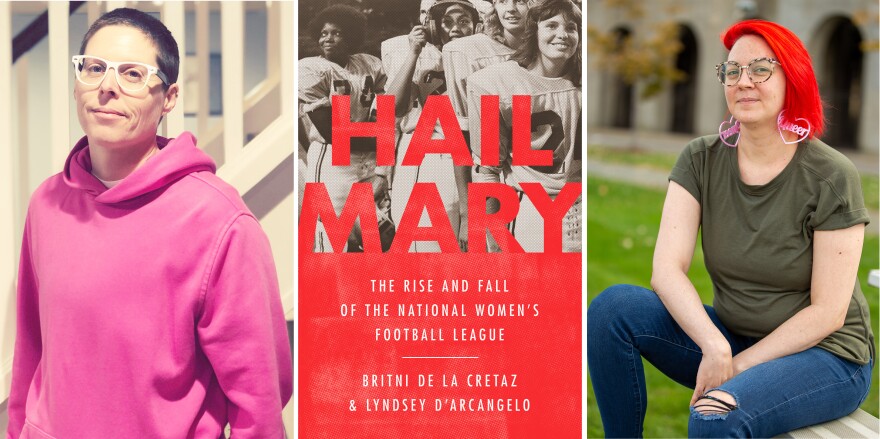You've probably heard of the WNBA.
Maybe even the Rockford Peaches mean something to you. That's a team from the former All-American Girls Professional Baseball League, featured in the hugely popular film A League of Their Own. with Geena Davis, Madonna and Tom Hanks.
But there's another women's professional league that you should have on your radar: the National Women's Football League.
No, it's not soccer. It's the helmet, shoulder pads and tackling kind of football. The NWFL lasted from the mid-1970s to 1988, when it shuttered and the teams broke apart.
A new book out this week titled Hail Mary: The Rise and Fall of the National Women's Football League explores the league's origins and what brought it to an end.
The book is co-written by sports writers Lyndsey D'Arcangelo and Britni de la Cretaz.
Morning Edition co-host A Martínez spoke with de la Cretaz about the under-recognized players who shook the American football world. You might've read their sports coverage in Sports Illustrated or book reviews here on NPR.
Listen here and continue below for the interview's highlights:
On how the league started, and its founder, Sid Friedman
"The thing about Sid is that he cared more about publicity than he did about the game. Some of the coaches he recruited were former NFL players, and so they were serious in that regard. But then he also envisioned things like tearaway skirts and jerseys, and he reportedly sent a Hustler photographer out to practices to photograph the women who were appropriately horrified by this.

The thing about this league is that most of the owners were men, and they got into this because they believed in the potential of women's football is an untapped market. But they also thought that they would put money in and they would be financially profitable within a couple of years. And that's just not the reality of any sports league, let alone a Women's Football League that has sexism and other things to deal with. So there was these unrealistic expectations on the part of the owners that these teams would make a lot of money right away, and that just didn't happen. The men were not millionaires or billionaires. They were putting in like $11,000 to start a team, and then they were surviving on ticket sales, ad space in the programs, asking for community sponsorships, selling raffle tickets, things like that.
On the makeup of the players
I was really surprised by the sheer diversity of who came out for these teams, and all kinds of diversity, racial diversity, diversity and sexual orientation. We had hairdressers and truck drivers and teachers and stay-at-home mothers. Some of the players were as young as 17. Others were in their 40s.
On battling against homophobia
These players, a lot of them were gay, right? Many of them weren't, but a lot of them were. Some of the teams, including the Dallas Bluebonnets, formed in a lesbian bar. The teams themselves were actually considered to be a safe place away from homophobia. Even the straight players, for a lot of them it was their first time spending much time with gay women. Not a lot of people were openly gay at the time. And for them, it shaped their social politics to this day.
But for the lesbians on the team, the team and those lesbian bars actually served a very similar purpose. It was a place where they could be who they were, and be it safely, and be in community with other people like them.
The media, however, was very quick to ask players about their presumed male partners and how those male partners might have felt about them playing such a dangerous and masculine sport like football. They often ... [were] written off as nothing but a bunch of lesbians. Some of the women dealt with slurs being yelled while they were practicing or things like that.
On sexism and how the media covered the league
The interesting thing is that there's lots of media coverage at the beginning when the teams are launching, because they are a sideshow. They are a gimmick. They are a curiosity to the people who are writing and reading about them. The coverage is very skewed by the perspective of the people who are writing the stories. Usually, they're men. They're sports writers. So the play-by-play is great, I can tell you what the game scores were.
But in the interviews with the players, it's so clear that the only questions that are being asked are things about how football helps their weight, whether or not they're 'women's libbers.' Because remember, this is during second-wave feminism. Some people thought the only reason that women would be playing football was because they must be part of the dreaded women's liberation movement and it was some sort of feminist statement.
The other thing that's really interesting about the media coverage is that when we talk to some of the players, they actually say they were misquoted in the paper or didn't say some of the things that were written and attributed to them. I think it raises really important questions about even how much we can rely on those primary archival sources, because they are so filtered through the lens of the people that were writing them in the time in which they were written."
Listen to more of de la Cretaz's conversation on Morning Edition here.
Reena Advani edited this story for broadcast and Nell Clark adapted it for the Web.
This story originally appeared in the Morning Edition live blog.
Copyright 2023 NPR. To see more, visit https://www.npr.org.



